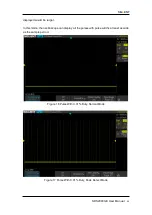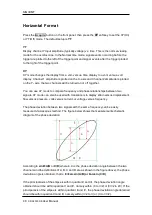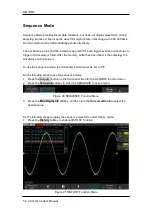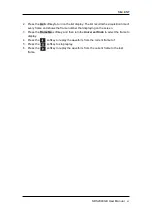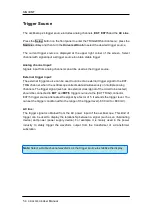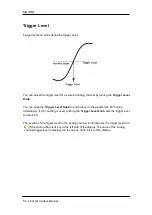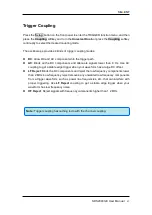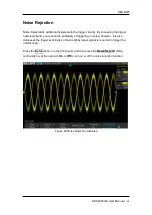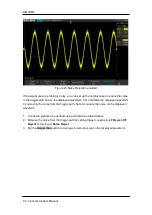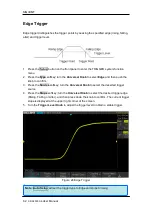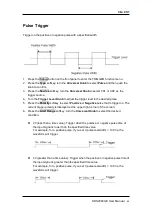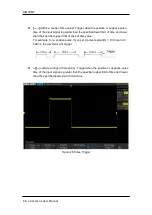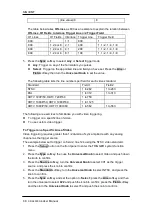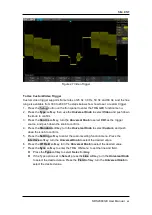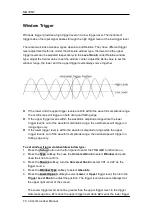
SIG
L
ENT
SDS2000X-E User Manual
55
Trigger Mode
The oscilloscope’s trigger mode includes auto, normal and single. The trigger mode
affects the way in which the oscilloscope searches for the trigger.
After the oscilloscope starts running, the oscilloscope operates by first filling the
pre-trigger buffer. It starts searching for a trigger after the pre-trigger buffer is filled and
continues to flow data through this buffer while it searches for the trigger. While searching
for the trigger, the oscilloscope overflows the pre-trigger buffer and the first data put into
the buffer is first pushed out (First Input First Out, FIFO).
When a trigger is found, the pre- trigger buffer contains the events that occurred just
before the trigger. Then, the oscilloscope fills the post- trigger buffer and displays the
acquisition memory.
Press the
Auto
,
Normal
and the
Single
buttons on the front panel to select the desired
trigger mode, and the corresponding status light will be lighted.
In the
Auto
trigger mode (the default setting), if the specified trigger conditions are
not found, triggers are forced and acquisitions are made so that signal activity is
displayed on the oscilloscope. The waveforms may not be stable on the display.
The
Auto
trigger mode is appropriate when:
Checking DC signals or signals with unknown levels or activity.
When trigger conditions occur often enough that forced triggers are
unnecessary.
In the
Normal
trigger mode, triggers and acquisitions only occur when the specified
trigger conditions are found. Otherwise, the oscilloscope holds the original waveform
and waits for the next trigger.
The
Normal
trigger mode is appropriate when:
You only want to acquire specific events specified by the trigger settings.
Triggering on an infrequent signal from a serial bus (for example, I2C, SPI, CAN,
LIN, etc.) or another signal that arrives in bursts. The
Normal
trigger mode lets
you stabilize the display by preventing the oscilloscope from auto- triggering.
In the
Single
trigger mode, the oscilloscope waits for a trigger and displays the
waveform when the trigger condition is met and then stops.
The
Single
trigger mode is appropriate when:
To capture single event or a periodic signal.
To capture burst or other unusual signals.
Содержание SDS2000X-E Series
Страница 1: ...User Manual SDS2000X E Series Digital Oscilloscope UM0102E E01A SIGLENT TECHNOLOGIES CO LTD...
Страница 14: ......
Страница 29: ...SIGLENT SDS2000X E User Manual 3 Appearance and Dimensions Figure 1 Front View Figure 2 Top View...
Страница 69: ...SIGLENT SDS2000X E User Manual 43 Figure 13 x Interpolation Figure 14 Sin x x Interpolation...
Страница 98: ...SIGLENT 72 SDS2000X E User Manual Figure 29 Relative Window Trigger...
Страница 100: ...SIGLENT 74 SDS2000X E User Manual Figure 30 Interval Trigger...
Страница 103: ...SIGLENT SDS2000X E User Manual 77 Figure 32 State Dropout Trigger...
Страница 105: ...SIGLENT SDS2000X E User Manual 79 Figure 33 Runt Trigger...
Страница 125: ...SIGLENT SDS2000X E User Manual 99 Figure 49 CAN Trigger...
Страница 129: ...SIGLENT SDS2000X E User Manual 103 Figure 51 LIN Trigger...
Страница 162: ...SIGLENT 136 SDS2000X E User Manual...
Страница 200: ...SIGLENT 174 SDS2000X E User Manual Figure 95 Built in Arb interface...
Страница 206: ...SIGLENT 180 SDS2000X E User Manual Figure 100 WiFi setting menu...
Страница 215: ...SIGLENT SDS2000X E User Manual 189 Figure 108 Option Information...





